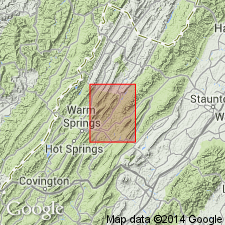
- Usage in publication:
-
- Lurich formation
- Modifications:
-
- Named
- Dominant lithology:
-
- Limestone
- Conglomerate
- Dolomite
- AAPG geologic province:
-
- Appalachian basin
Summary:
Named the Lurich formation for Lurich, Giles Co., VA. Consists of calcilutite of variable thickness that passes down into beds containing nodular black chert and beds of chert-pebble conglomerate in dolomite. The Lurich can be divided into (ascending) the Blackford member (chert-pebble conglomerate and dolomite), Elway member (DINORTHIS-bearing calcilutite with black chert nodules), and Five Oaks member (calcilutite). Thickness is approximately 300 feet. Unit overlies the Canadian series and underlies the Lincolnshire limestone. The Lurich formation is of Middle Ordovician (Chazyan) age.
Source: GNU records (USGS DDS-6; Reston GNULEX).

- Usage in publication:
-
- Lurich formation
- Modifications:
-
- Overview
- AAPG geologic province:
-
- Appalachian basin
Summary:
The Lurich formation in VA can be divided into a lower basal clastic unit and an upper Five Oaks member. The basal clastic unit consists of 169 feet of dark gray and olive gray, fine- to very fine-grained, thin- to medium-bedded limestone with limestone conglomerate, shaly interbeds, and black chert; unit is equivalent to the Blackford and Elway members of Kay (1956). The Five Oaks member consists of 116 feet of olive gray and medium gray, aphanitic, thin- to medium-bedded limestone or calcilutite. The Lurich overlies the Beekmantown formation and underlies the Lincolnshire limestone. Unit is of early Middle Ordovician age.
Source: GNU records (USGS DDS-6; Reston GNULEX).
For more information, please contact Nancy Stamm, Geologic Names Committee Secretary.
Asterisk (*) indicates published by U.S. Geological Survey authors.
"No current usage" (†) implies that a name has been abandoned or has fallen into disuse. Former usage and, if known, replacement name given in parentheses ( ).
Slash (/) indicates name conflicts with nomenclatural guidelines (CSN, 1933; ACSN, 1961, 1970; NACSN, 1983, 2005, 2021). May be explained within brackets ([ ]).

